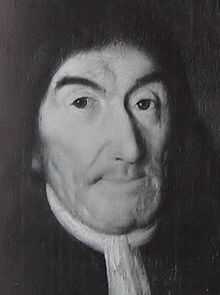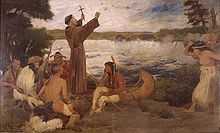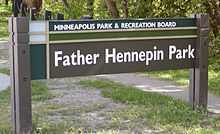Louis Hennepin
| Louis Hennepin | |
|---|---|
 | |
| Born |
Antoine Hennepin May 12, 1626 Ath, Spanish Netherlands (present-day Belgium) |
| Died |
ca. 1705 Rome, States of the Church |
| Occupation | Priest, Missionary |
| Organization | Franciscan Récollets |
| Religion | Roman Catholic |
Father Louis Hennepin, O.F.M. baptized Antoine, (12 May 1626 – c. 1705) was a Catholic priest and missionary of the Franciscan Recollect order (French: Récollets) and an explorer of the interior of North America.
Hennepin was born in Ath in the Spanish Netherlands (now in the province of Hainaut, Belgium). In 1659 Béthune, the town where he lived, was captured by the army of Louis XIV of France.

At the request of Louis XIV the Récollets sent four missionaries to New France in May 1675, including Hennepin, accompanied by René Robert Cavelier, Sieur de la Salle. In 1678, Hennepin was ordered by his provincial superior to accompany La Salle on an expedition to explore the western part of New France. Hennepin was 39 when he departed in 1679 with La Salle from Quebec City to construct the 45-ton barque Le Griffon, sail through the Great Lakes, and explore the unknown West.
Hennepin was with La Salle at the construction of Fort Crevecouer (near present-day Peoria, Illinois) in January, 1680. In February, La Salle sent Hennepin and two others as an advance party to search for the Mississippi River. The party followed the Illinois River to its junction with the Mississippi. Shortly thereafter, Hennepin was captured by a Sioux war party and carried off for a time into what is now the state of Minnesota.[1] In September, Hennepin and the others were given canoes and allowed to leave, eventually returning to Quebec. Hennepin returned to France and was never allowed by his order to return to North America.[2]
Local historians credit the Franciscan Récollect friar as the first European to step ashore at the site of present-day Hannibal, Missouri.[3]
Two great waterfalls were brought to the world's attention by Louis Hennepin: Niagara Falls, with the most voluminous flow of any in North America, and the Saint Anthony Falls in what is now Minneapolis, the only waterfall on the Mississippi River. In 1683, he published a book about Niagara Falls called A New Discovery.
Named after Hennepin

Most places named after Hennepin are found in the United States:
Minnesota
- Hennepin County, Minnesota, whose seat is Minneapolis
- Hennepin Avenue, in Minneapolis
- The Father Louis Hennepin Bridge, across the Mississippi River in Minneapolis
- Father Hennepin State Park, in Isle, Minnesota
- A Great Lakes wood-hulled steamer built in 1888 which sank in 1927
- The city of Champlin, Minnesota, the site historians report where he first crossed the Mississippi in 1680, holds an annual Father Hennepin Festival on the 2nd weekend of June that includes a reenactment of Father Louis Hennepin crossing the Mississippi River.
- Hennepin Island is in the Mississippi River at St. Anthony Falls. Although it is no longer an island, it extends into the river and houses the Saint Anthony Falls Laboratory at the University of Minnesota, a five-unit hydroelectric plant, owned by Xcel Energy, and the Main Street substation – serving downtown Minneapolis.
- Father Hennepin Bluffs Park lies on the east bank of the Mississippi River adjacent to Hennepin Island. It is administered by the Minneapolis Park and Recreation Board and features picnic areas, a bandshell, and Heritage Trail plaques.
- Hennepin Room at the Minneapolis Hilton
- Father Hennepin Memorial stands on the grounds of Saint Mary's Basilica in Minneapolis.
New York
- Hennepin Road in Grand Island, New York
- Hennepin Avenue on Cayuga Island in Niagara Falls
- Hennepin Room at the Niagara Falls Conference Center in Niagara Falls
- Hennepin Park, a park located on the corner of 82nd Street and Bollier Avenue in Niagara Falls
- Hennepin Hall, a residence hall at Siena College, Loudonville, New York
- Hennepin Park, a park located in the East Lovejoy neighborhood of Buffalo
- Hennepin Parkway, also known as Hennepin Street, a street on the north side of Hennepin Park in the East Lovejoy neighborhood of Buffalo
- Hennepin Farmhouse Saison Ale (beer) from Brewery Ommegang in Cooperstown
Michigan
- Point Hennepin, the northern tip of Grosse Ile, an island on the Detroit River south of Detroit
- Hennepin Street in Garden City, MI
- Hennepin Road in Marquette, MI
- Hennepin, significant as the first self-unloading bulk carrier.[4] Wreckage is located west of South Haven.
Illinois
- The city of Hennepin
- Hennepin Room at Starved Rock Lodge and Conference Centre in Utica
The few places outside the United States are found in Canada, all in Niagara Falls, Ontario:
- Father Hennepin Separate School
- Ontario Historical Plaque at Murray Avenue and Niagara River Parkway
- Hennepin Room at Sheraton Fallsview
Pop culture references to Hennepin
- The final track on the 2006 album 13 by Brian Setzer is entitled "The Hennepin Avenue Bridge." Its lyrics tell a fictitious story of Fr. Hennepin and his leap from the Hennepin Avenue Bridge over the Mississippi River.
- Tom Waits's Rain Dogs features track 12, 9th & Hennepin.
Books by Hennepin

Hennepin is the author of
- Description de la Louisiane (Paris, 1683),
- Nouvelle découverte d'un très grand pays situé dans l'Amérique entre le Nouveau-Mexique et la mer glaciale (Utrecht, 1697), and
- Nouveau voyage d'un pays plus grand que l'Europe (Utrecht, 1698).
"A New Discovery of a Vast Country inVoyage America" in two volumes. Reprinted from the second London issue of 1698 with facsimiles of original title-pages, maps, and illustrations, and the addition of Introduction, Notes, and Index By Reuben Gold Thwaites. A.C. McMlurg & Co., Chicago, 1903 The truth of much of Hennepin's accounts has been called into question — or flatly denied — notably by the American historian Francis Parkman. In the words of the 1913 Catholic Encyclopedia:
Hennepin has been denounced by many historians and historical critics as an arrant falsifier. Certain writers have sought to repel this charge by claiming that the erroneous statements are in fact interpolations by other persons. The weight of the evidence is however adverse to such a theory.—Catholic Encyclopedia, 1913
References
- ↑ Shea, John Gilmary. DESCRIPTION of LOUISIANA,By FATHER LOUIS HENNEPIN, RECOLLECT MISSIONARY: Translated from the Edition of 1683, and compared with the Novella Decouverte, The La Salle Documents and other Contemporaneous Papers pages 368-370. New York: John G Shea, 1880
- ↑ Dictionary of Canadian Biography
- ↑ National Geographic Magazine, July-1956, Vol CX-Number 1, pg 135-136
- ↑ Valerie Olson van Heest, writer and director (2007). She Died a Hard Death: The Sinking of the Hennepin (DVD). Michigan Shipwreck Research Associates.
External links
- Full text of Nouvelle découverte d'un très grand pays situé dans l'Amérique entre le Nouveau-Mexique et la mer glaciale, from the Bibliothèque nationale de France
- Full text of Nouveau voyage d'un païs plus grand que l'Europe, from the Bibliothèque nationale de France
- History Article about Louis Hennepin
- Article on Louis Hennepin. in the Catholic Encyclopedia.
|